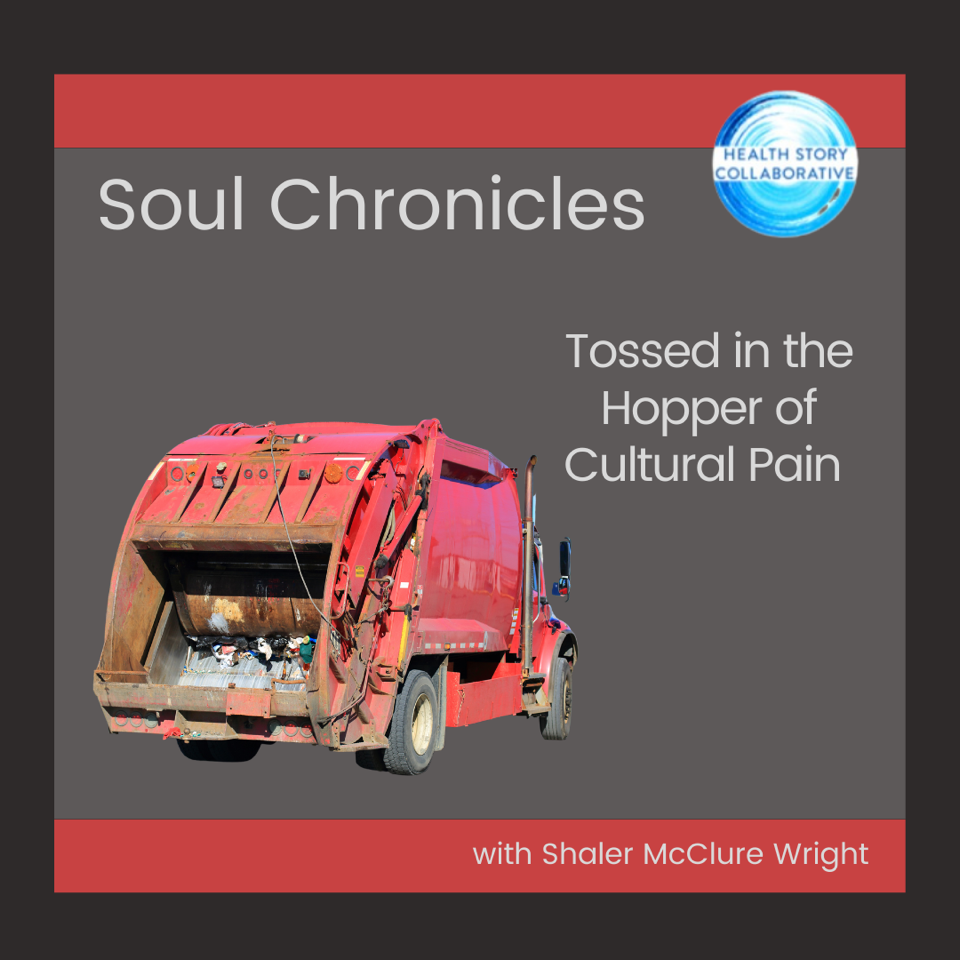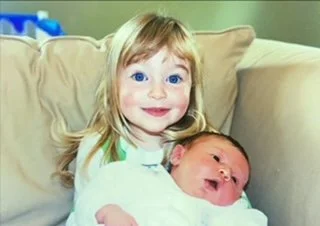Segment 9 in our series Soul Chronicles for the Chronically Ill
by Shaler McClure Wright
Introduction
You’re listening to episode nine of Soul Chronicles, offering a soulful perspective on how to navigate the unique challenges of living with ongoing health conditions. Special thanks to Health Story Collaborative for hosting this monthly audio column. My name is Shaler McClure Wright and I’m a writer/creative living with Chronic Inflammatory Response Syndrome.
Story - Tossed in the Hopper of Cultural Pain
When I think of a soulful approach to life I think of seeking beauty. Calling attention to beautiful moments as they unfold, or reflecting on those that may have passed without notice. But right now I’m immersed in its opposite; something shadowy and so ominous it can’t be ignored. So here is my warning—if you’re looking for butterflies, glitter and light, you won’t find them here today. Because before I can make my way back to the restorative path of all-things-good in the world, I need to acknowledge the looming presence of current events that threatens to eclipse the natural light of beauty and soul.
We’re in the grips of a pervasive cultural pain to which no one is immune. It’s uncomfortable, unsettling and it’s spreading. When we try to discuss it publicly, we strain for civility, and find ourselves having to avoid words that might be considered inflammatory, and sometimes that leaves us without words at all. So we’re stuck in a cycle of speak/regret/retreat, and each round of failed conversation creates more pain.
I’ve chosen a name for this condition. Sanitation Syndrome.
I call it Sanitation Syndrome because ironically, the more we try to sanitize it, the more we enable it to grow. By sanitize I mean making light of divisive comments or avoiding conversation about it altogether. And if left unchecked, Sanitation Syndrome will gather strength, brewing in the background, until all of a sudden we find ourselves steeped in a national infection.
How do we learn to recognize it? Sanitation Syndrome occurs when words are weaponized to divide us, and once divided, we can no longer speak the same language. The best word to describe Sanitation Syndrome is toxic, and our well-intentioned attempts to contain it actually end up making things worse, by compressing it into something smaller, more dense and more toxic. Sanitation Syndrome is spreading through every corner of our country by seeping into our bodies with just enough heat to smolder, like a fire that burns from the inside out.
In order to reflect on this national illness (though I’d still prefer to reflect on beauty), I’ll choose an image to represent the aspects of Sanitation Syndrome that are hardest to visualize. Not surprisingly, I’m choosing a piece of sanitation equipment—a garbage truck—to represent the vehicle for both its containment and growth.
Imagine one big national garbage truck making rounds on a sweltering summer day with the purpose of containing all things exposed to Sanitation Syndrome—including people. It’s like we’re all being unceremoniously tossed in its hopper, with its giant compactor pressing us ever closer together, until finally we’re squished into one big brick of unrecognizable waste. And once we’ve been reduced to garbage, we begin to simmer with a smell most aptly associated with toxic stew. We think our lives will be less messy if we compact the trash. But as it turns out, compacted trash takes up less space, but it’s no less nasty. It’s simply more concentrated.
I admit, I’ve tried to insulate myself from the reaching arms of our national garbage truck, but in doing so my world has grown smaller and smaller. And that’s not good. Truth is, Sanitation Syndrome is fueled by the pain of despair, and no amount of padding is thick enough to insulate us from its friction or burn.
It’s not that I don’t care about the issues we face—I care deeply—but like many of you, I need to balance awareness with health. And right now, to be honest, I’m failing. When I clench with instinctive resistance, my desire for self protection feels like a vice tightening around my body. So insulation isn’t an option. We need to face this sickness head-on, or we might find ourselves wrapped in a vice and crushed in a hopper all at once.
When our lives have been compacted into one big brick of toxic waste it leaves us gobsmacked—shocked—and unable to think clearly. It’s hard to take action. Like Bill Murray’s conundrum in “Groundhog Day,” waking up again and again to the same problems, we find ourselves stuck in the throes of recurring gobsmack attacks.
So how might we gain perspective about this predicament? By educating ourselves as much as we can. Think of it this way, learning about Sanitation Syndrome is not so different from hearing a diagnosis we don’t want to hear, or conducting research on a medical condition we’d rather not have—so perhaps we’re better prepared to do this work than we realize.
There’s something potent about the collective endurance of cultural pain, and the possibility leaves me wondering, “If enough of us can endure it, can we also clear it? Can we banish Sanitation Syndrome from our lives?”
I’ve spoken before about the transformative potential of personal experience and I’d like to share an example. Just yesterday I had an experience of uncontrollable trembling, for no apparent reason other than hearing the news stream in the background while I was cooking. Like the fire of Sanitation Syndrome—burning from the inside out—my trembling began as an invisible inner tremor. But eventually it got so bad I couldn’t hold a knife steady enough to chop vegetables.
Soulfully speaking, trembling can indicate a profound experience, transformation on a cellular level. Our body signals us with a combination of tears, rage, trembling, or dizziness. We might feel disoriented, but it’s actually a process of reorientation, and in the case of Sanitation Syndrome, a rejection. I believe a collective shake-out may be the best way to begin the process of collective healing.
In his book “Healing Trauma”, Dr Peter Levine suggests, “People do, in fact, possess the same built-in ability to shake off threats that animals do. I have found that, if given appropriate guidance, human beings can and do shake off the effects of overwhelming events and return to their lives.”
So if the first step is a shake-out, then the second step would be a reconstitution. How do we begin to transform our toxic stew into something more palatable?
Transformation is a complex and exhausting process, some of which is within our control, but much of it is a mystery, perhaps even requiring a leap of faith. And like our slimy, compacted waste, it can be messy. As an example, let’s look at the metamorphosis of a butterfly.
In the Scientific American article “How Do Caterpillars Turn Into Butterflies?”we learn that “first, the caterpillar digests itself, releasing enzymes to dissolve all of its tissues. If you were to cut open a chrysalis, you’d find a soupy meltdown of the caterpillar's body.”
Caterpillar soup contains highly specialized imaginal discs that undergo rapid cell division, differentiation and growth. Eventually these disks become imaginal cells that make up the physiology of a butterfly. The mystery of a butterfly’s transformation is rooted in these imaginal cells. (And of course I see a connection between the words imagination and imaginal.)
Evolution biologist Dr. Elisabet Sahtouris refers to the connection between the current state of our country and the birth of a butterfly in her book “EarthDance”:
“If we see ourselves as imaginal discs working to build the butterfly of a better world, we will understand that we are launching a new ‘genome’ of values and practices, to replace that of the current unsustainable system. We will also see how important it is to link with each other in the effort, to recognize how many different kinds of imaginal cells it will take to build a butterfly with all its capabilities and colors.”
So what do you think? Can we weather our Sanitation Syndrome garbage truck ride with the transformative grace of a butterfly? I warned you there would be no butterflies in this chronicle, and there aren’t. Yet. But we can visualize the possibility. And so I leave you with this vision of emerging beauty— Imagine how precious it would be to gather for a conversation that’s free of disinformation, flowing with words as beautiful as the first unfolding of a butterfly's wings.
Go here for more episodes of our Soul Chronicles series.
Shaler McClure Wright is fascinated with the mysteries of creative process, the healing power of creativity, and the creative synthesis of method acting, intuitive learning and depth psychology. A graduate of Wesleyan University and The Actors Studio, Shaler has worked as an actor, writer and educator for more than 40 years, and lives in southeastern Connecticut with her husband and son.
Website: www.shalermcclurewright.com
Instagram: https://www.instagram.com/soulchronicles22/, @soulchronicles22
BioSite: https://bio.site/soulchronicles






























